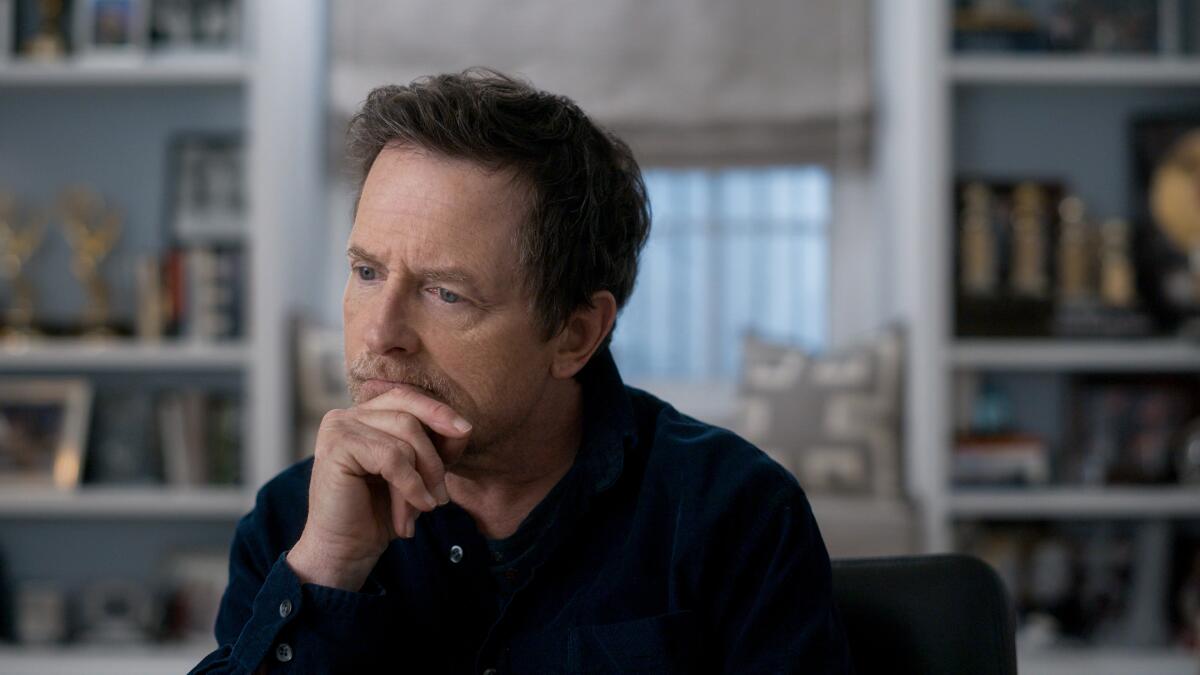Commentary: In ‘Still,’ Michael J. Fox reminds us that despite Parkinson’s, he’s here. Thank goodness

- Share via
Is there anything less controversial than liking — even loving — Michael J. Fox? He’s likable, he’s lovable. Even when he’s playing someone not especially likable or lovable, one feels, “How nice it is to see you, Michael J. Fox.”
In later years — as his Parkinson’s, which was diagnosed in 1991 when he was 29 and made public in 1998, has progressed — this feeling has taken on an extra dimension: that of keeping an eye on an actor toward whom one can feel proprietary, even protective; he’s a stranger who feels like family.
This affection has been poured into Davis Guggenheim’s documentary portrait “Still: A Michael J. Fox Movie,” premiering Friday on Apple TV+. The title has multiple meanings: Although Parkinson’s is characterized by uncontrollable tremors, its endgame may be paralysis. But Fox, a constitutionally speedy person, also speaks of learning how to be still within his life, to slow down, look around. And, of course, it also can be read as “still here.”
It’s an engaging, satisfying film whose wealth of fresh material should make up for whatever aspects of Fox’s career Guggenheim has decided not to cover. (“Light of Day,” where are you?) Those few humans who have no experience of the actor will get a good idea of what they’ve been missing. But like a guest commandeering the microphone at a wedding, I come not just to review a movie but to praise its subject and to take the occasion to state loudly, for the record, that canceling “The Michael J. Fox Show” with seven episodes left unaired was a crime, NBC. That has been on my mind for a while.
I knew “Family Ties” and “Back to the Future” (Parts 1 through 3) in their time, but it was when I was editing at a large-format magazine called L.A. Style, sometime around 1990, that I began to see Fox, literally, in a different light. To illustrate a feature, we ran a striking photograph of him crouched barefoot, in a photo studio, on a tree stump, not looking like a kid. I may or may not have been the one who titled the piece “The Natural,” but in any case, that’s how I began to think of him. I’d always liked him, but this photograph, even more than the story, made me look closer at a now-grown actor whose gifts were easy to take for granted.
Fox first got famous on a television series; the “Back to the Future” films — another series — made him even more famous. The element of time, of going through life alongside the characters, weaves them — and the actors who play them — into our ongoing world in a deep and special way. Back before television, movies often came in series, from six “Thin Man” pictures to Mickey Rooney’s 16 “Andy Hardy” films, which helped to establish a relationship with the audience.
It isn’t only because of their similar stature that Fox reminds me of Rooney; they shared an energy, physicality, musicality, fleetness and a bravado that could play as arrogant or sweet, as needed — not to mention an appealing croak in their speech. And each has personified some now-obsolete idea of what it means to be an American, even if Fox is Canadian.
He was made for comedy, though his comedy has always had a streak of drama, and he’s always acquitted himself well when the drama was straight. (Brian De Palma’s “Casualties of War,” the Vietnam drama in which he plays the moral center, is probably the best known of these, but check out him out in Paul Schrader’s “Light of Day,” one of the best rock films ever.)
The two-episode “Family Ties” arc in which he meets and falls in love with a girl played by Tracy Pollan, whom he married in 1988, shows how serious he could be in the context of a sitcom. And later roles, in what might be called the Visibly Diminished Years, brought out a streak of puckish wickedness, as with the manipulative Louis Canning, whom Fox played in 26 episodes of “The Good Wife” and two of “The Good Fight,” or an episode of “Curb Your Enthusiasm” in which he weaponizes his tremors against Larry David.

“Still” is an inside job, with access to family photos and films and Fox himself as the narrator and sole interview subject. The customary archival clips take us through the years, and dramatic re-creations, not many, thankfully, fill in some gaps.
The film is explicit about the mounting challenges Fox faces and those he faced before we knew he was facing them. We see him working on walking with his physical therapist and falling on the street on the walk to his office (and recovering with a joke). The movie is admiring, but not fawning, and makes a fetish neither of Fox’s suffering nor his equanimity — sometimes amounting to black humor — in dealing with it.
“If I’m still here in 20 years,” Fox says here, “I’ll either be cured or a pickle.”
As in his books, most recently the 2020 “No Time Like the Future: An Optimist Confronts Mortality,” which covers much of the same ground as “Still,” Fox is open about the bad times, some of which came out of the good times. He raised a little hell back in the ’80s, but unlike some of Hollywood’s flush, famous young, Fox left no trail of tabloid appearances. He began drinking heavily after his diagnosis, enough to call himself an alcoholic, but got sober after Pollan asked him, “Is this what you want? Is this what you want to do?”
In a rush to work after learning of his Parkinson’s — “a gift that keeps on taking” — he made a few movies that did not fare well with audiences or critics (including one, “Life With Mikey,” in which he plays a children’s talent agent, that I like a lot, whatever anyone says). But every actor has experienced something of the sort, and “Still” moves on quickly to “Spin City,” one of the ’90s smartest sitcoms, which used every bit of his body and brain. It was midway through his four-year run that he made his Parkinson’s public; he left when he felt he wasn’t up to the demands and turned his attention to the Michael J. Fox Foundation, which has raised more than $1 billion dollars for Parkinson’s research.
But after a break he went back to acting — he can play any part, he’s said, as long as that person has Parkinson’s — including a third sitcom, the aforementioned, excellent, insufficiently appreciated “The Michael J. Fox Show,” in which, as a beloved New York news anchor returning to work, he played a version of his own story. (It was also his first role as a TV dad.)
Even as his condition has progressed, Fox, who has retired once again from acting — his Wikipedia entry now lists him as a “Canadian-American activist” — has not been shy about showing himself on talk shows, news shows and at public events. Lately, he’s been out stumping for “Still.”
While medications allow him to present what might be called the best version of his worsening self, it’s rare for a disabled Hollywood figure to be so visibly out front, especially when that picture is at odds with the one we hold in our head. (At the same time, even with his symptoms and about to turn 62, he remains somehow doggedly boyish.)
A recent television interview with Jane Pauley led to a spate of online articles headlined with some variation of “Michael J. Fox says he won’t live to 80.” It’s a predictably sensational bit of clickbait, but on some level it speaks to how much we want him in the world. He’s family, after all.
‘Still: A Michael J. Fox Movie’
Where: Apple TV+
When: Anytime, starting Friday
Rated: R (may be unsuitable for children younger than 17, with an advisory for coarse language)
More to Read
The complete guide to home viewing
Get Screen Gab for everything about the TV shows and streaming movies everyone’s talking about.
You may occasionally receive promotional content from the Los Angeles Times.







